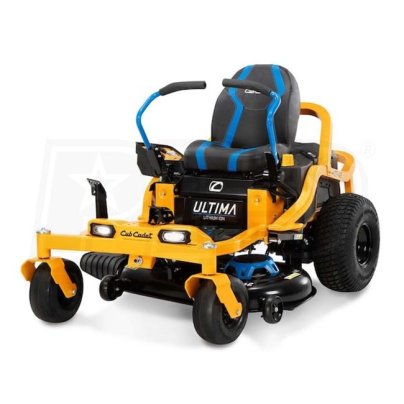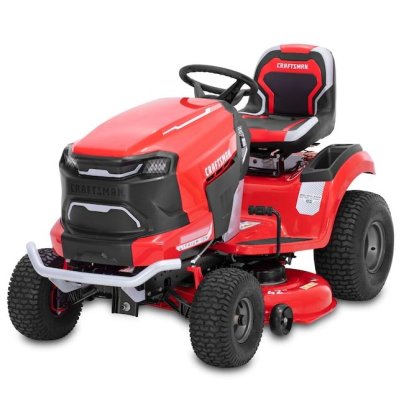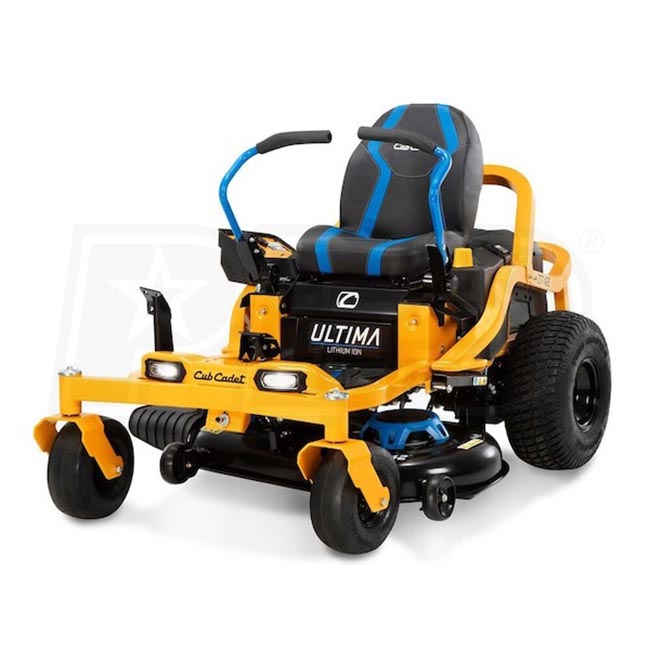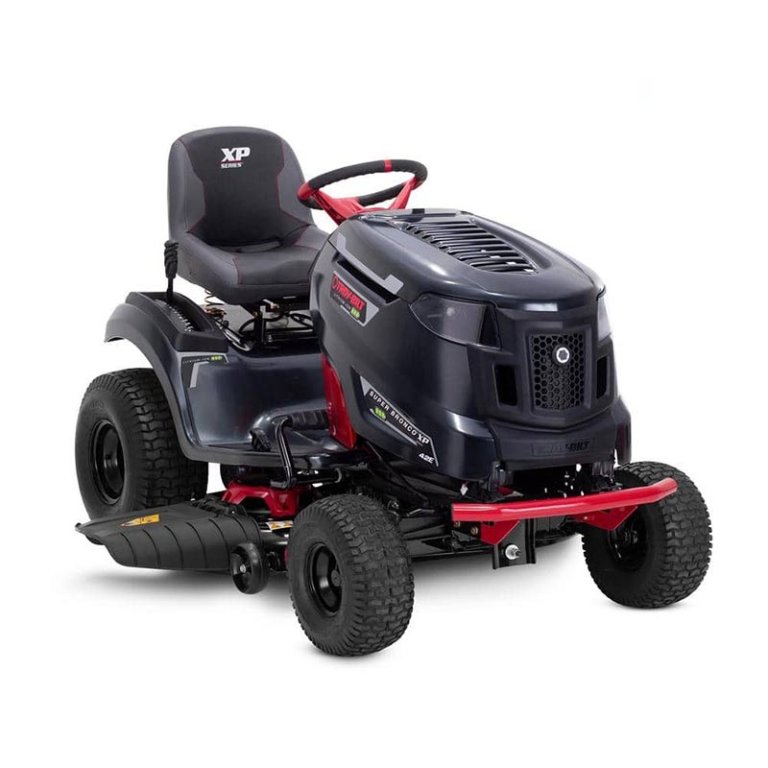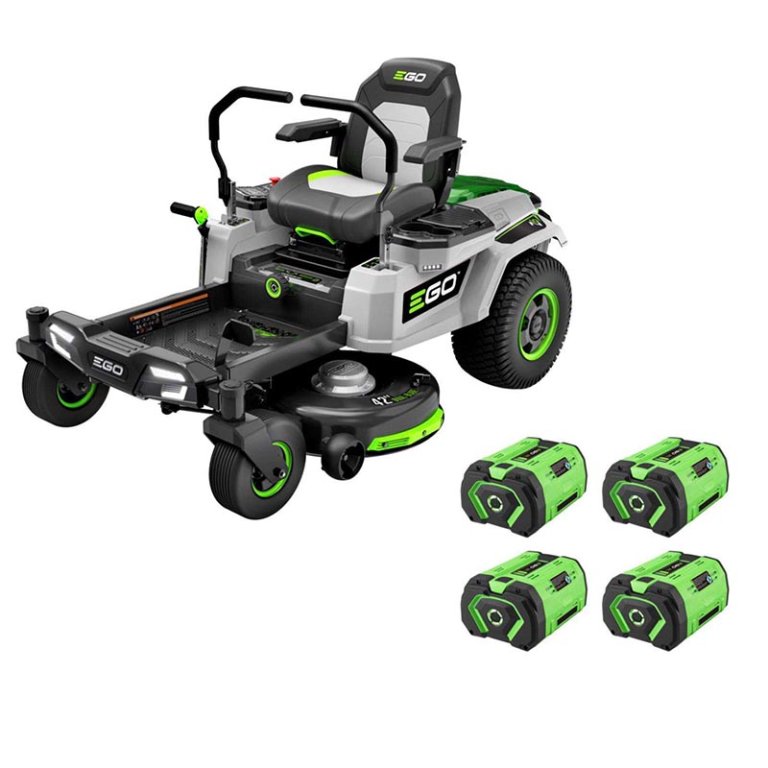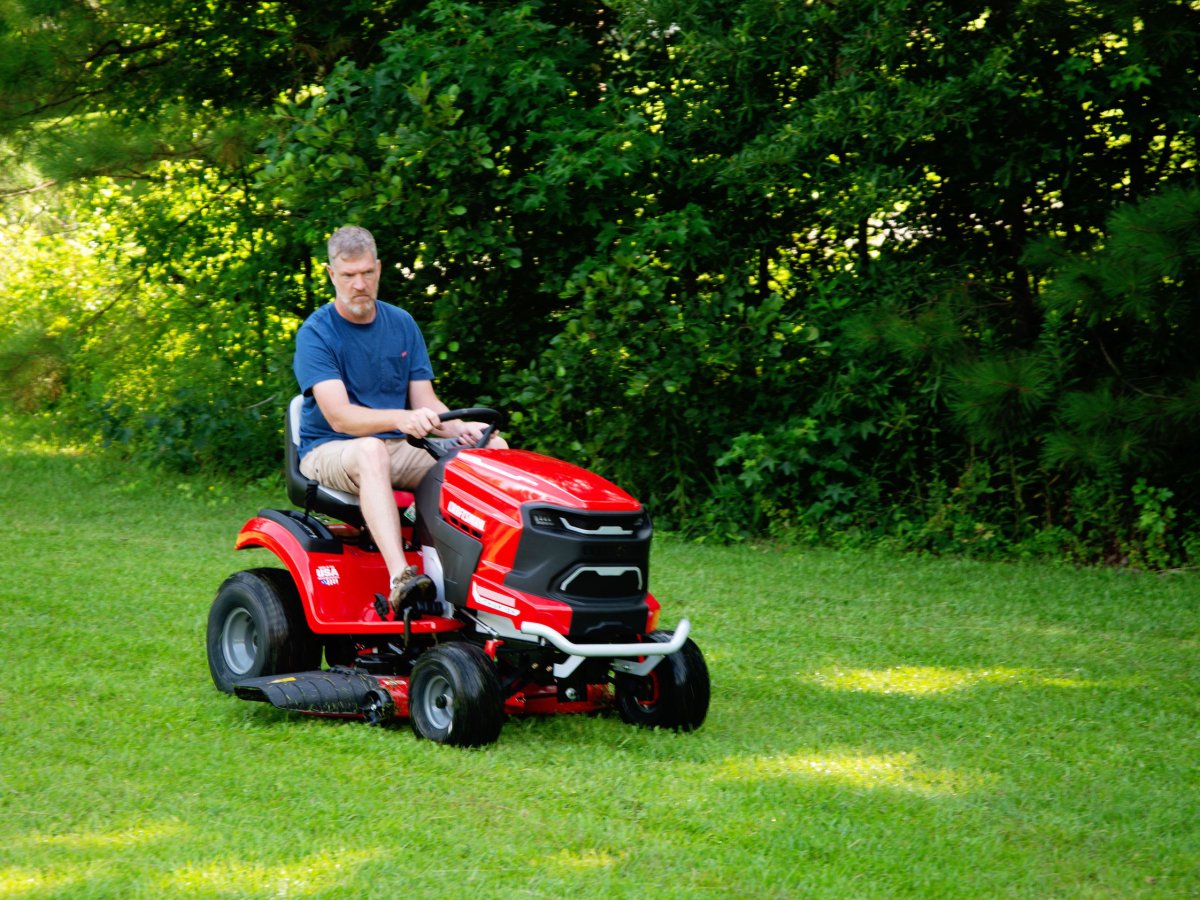
We may earn revenue from the products available on this page and participate in affiliate programs. Learn More ›
If you’re willing to spend a premium price for a battery-powered electric riding mower, you should expect quality in return. I can attest to the quality and performance of the four models in this guide because I spent 5 to 6 hours mowing 13 acres with each one. Some of their standout features include deep-cycling lithium batteries, efficient brushless motors, plush seats, and simple controls. But what distinguishes them from lesser models is their speed, smooth operation, and reliability.
Earlier battery-powered riding mowers came with serious limitations in terms of range and operator comfort, but the latest batteries, motors, and software have addressed many of those shortcomings. Rechargeable battery technology has finally matured to become a competitive option for riding lawn mowers. In the review ahead, I’ll provide an overview of the best battery-powered riding lawn mowers and share the highlights from my tests.
- BEST OVERALL: Cub Cadet Ultima ZT1 42E Zero-Turn Mower
- BEST BANG FOR THE BUCK: Troy-Bilt Super Bronco 42E XP Riding Mower
- BEST BATTERY LAWN TRACTOR: Craftsman 56V MAX Battery-Powered Riding Mower
- BEST BATTERY ZERO-TURN: Ego Power+ Z6 Battery-Powered Zero-Turn Riding Mower
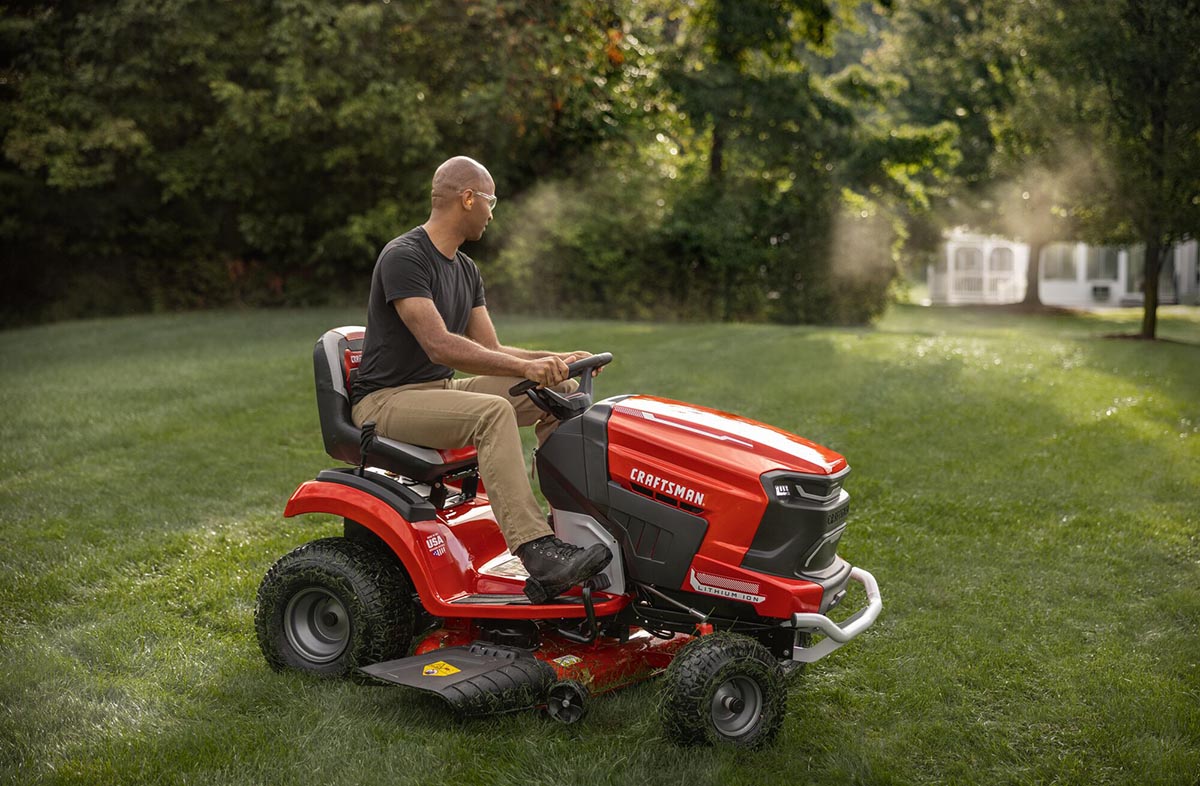
How We Tested the Best Battery-Powered Riding Lawn Mowers
In this guide, we wanted to showcase the most up-to-date battery-powered riding mowers available. We researched offerings from seven brands before finally settling on the four models showcased here. Each of the models we chose was newly released in 2021 or later. We limited our selections to riding lawn mowers that are powered by lithium-ion batteries because of their longer battery life, higher efficiency, deeper cycling ability, and rapid discharge capability compared to older sealed lead acid (SLA) batteries. For a mower to be considered, the manufacturer’s specifications had to show that it could cut at least one acre of grass per charge in a half hour or less.
We spent 4 months putting these battery-powered riding lawn mowers through a series of tests on a 2-acre property, mowing a combined total of 24 acres in the process. Starting with a full charge and grass at the typical height before mowing, we cut as much of the grass as possible until the battery ran out and recorded the total area mowed and runtime per charge. Again with the grass at normal height, we tested the maximum mowing speed on a 1-acre obstacle-free portion of the lot. Finally, we let the grass grow out for 3 weeks and mowed again to find out how extra-long grass would affect battery life and cut quality. Throughout testing, we recorded observations regarding comfort, handling, control layout, noise, and cut quality.
Our Top Picks
This roundup includes some of the newest and best battery-powered riding lawn mowers available. Whether you’re in need of a lawn tractor or a zero-turn riding mower, you will find a clean and quiet electric option here.
Best Overall
Cub Cadet Ultima ZT1 42E Zero-Turn Mower
Pros
- The most comfortable seat and smoothest overall ride among all the models tested
- Excellent runtime; mowed more than 2 acres per charge in our tests
- Smoother acceleration and stopping than any other model in the test group
- Very responsive controls with zero “play” in the lap bar movement
Cons
- The built-in battery requires an accessible power outlet within 10 feet
- Seat armrests are not included
Product Specs
- Battery: 56V 60Ah, built-in
- Deck: 42-inch, stamped steel
- Top mowing speed: 7 miles per hour (mph)
The best all-around battery-powered riding lawn mower comes from a giant in the industry. The Cub Cadet Ultima ZT1 42E is an electric zero-turn riding lawn mower with a built-in 56 volt (V) 60 amp hour (Ah) battery. In my test, it mowed just under 2 acres per charge.
For those who are new to battery-powered riding mowers, the first thing that may stand out is the sound—or the lack of sound, to be more precise. This Cub Cadet model ran almost silently with the blades disengaged, and it produced less than half the noise of a gas mower while mowing. More notable than the lack of noise, however, was the operational precision. Other battery riders I’ve tested have a certain amount of jerkiness when they start moving or come to a halt. But this one accelerated, decelerated, and turned smoothly, with very little play in the control bars.
The premium sewn seat was another standout feature. Although the mower does not come equipped with armrests, the seat bottom and back are the most comfortable of all the models I tested. Compared to the molded foam seats found on older riding mowers, the difference was night and day.
As for mowing performance, the deck produced enough airflow for maintenance mowing, but not enough to easily catch up after missing a week or two. By mowing at normal intervals (removing one third or less of the total grass height), the final product looked great without any special treatment. But if the lawn was allowed to grow too tall, the taller grass and weeds laid down during the first pass, requiring a second pass in the opposite direction for a perfect cut. This was common of all the battery-powered mowers in our test group.
Get the Cub Cadet battery-powered riding lawn mower at Cub Cadet or Power Equipment Direct.
Best Bang for the Buck
Troy-Bilt Super Bronco 42E XP Riding Mower
Pros
- Lowest purchase price among all of the mowers we tested
- Premium sewn seat with deep padding provides outstanding comfort
- Excellent weight balance makes it easy to operate on uneven terrain
- Impressive runtime; mowed more than 2.5 acres per charge in our tests
Cons
- Starting and stopping were somewhat jerky
- Mowing in reverse required extra steps at the control panel
Product Specs
- Battery: 56V 60Ah, built-in
- Deck: 42-inch, stamped steel
- Top mowing speed: 5.5 mph
Those looking to save a few bucks on a really good battery-powered riding lawn mower will want to take a look at the Troy-Bilt Super Bronco 42E XP. Despite being the most affordable of all the mowers we tested, this model’s mowing performance competes with the rest of the group. As a lawn tractor, it is capable of cutting the grass as well as towing implements such as a dump cart, lawn spreader, or aerator. It comes equipped with a built-in 56V 60Ah lithium battery and a 42-inch mowing deck. Other popular features include brushless motors, cruise control, LED headlights, and a premium sewn seat.
The Super Bronco 42E XP works much like gas-powered hydrostatic riding mowers. Two pedals on the right control direction and speed, while the brake pedal is located on the left. In operation, it was a tad jerky at the start and stop, especially when I first tried it. With some practice I figured out how to “ease” on and off in order to minimize the jolt.
As for the mowing runtime, the Super Bronco tied for first place with Craftsman’s tractor-style electric lawn mower, as it was able to mow a little more than 2.5 acres. The cut quality was similar to our best overall pick. Those who will use this machine for towing and other applications should expect even longer runtimes when the mower blades are not operating. In short, this model is a value-packed option. Its mowing performance is right up there with the best in its class, and it boasts an excellent runtime and nice comfort features.
Get the Troy-Bilt battery-powered riding lawn mower at The Home Depot or Northern Tool + Equipment.
Best Battery Lawn Tractor
Craftsman 56V MAX Battery-Powered Riding Mower
Pros
- TurnTight steering system significantly improves navigation around obstacles
- Excellent weight balance for climbing hills and towing a cart without slipping
- Premium sewn seat with plush padding and coil spring suspension for a comfortable ride
- Good mowing power and runtime for varying terrain and grass conditions
- Outstanding runtime; mowed more than 2.5 acres per charge in our tests
Cons
- Mowing in reverse required extra steps at the dashboard
Product Specs
- Battery: 56V 60Ah, built-in
- Deck: 42-inch, stamped steel
- Top mowing speed: 6 mph
With the power and balance to mow and tow on varying terrain, lawn tractors are the workhorses of large, diverse landscapes and suburban homesteads. The Craftsman 56V MAX features a cushy premium seat, a powerful 56V 60Ah built-in battery, and a 42-inch mowing deck to get the job done quickly, quietly, and comfortably. But the thing that really stood out to me was its maneuverability.
I was super impressed by the way the Craftsman electric lawn tractor handled all kinds of terrain and navigated around obstacles in the landscape. The mower’s weight was well balanced, so it could mow perpendicular to moderate slopes and tow a dumpcart uphill with no risk of slipping. Even more impressive was the TurnTight system’s 5.5-inch turning radius. A hard turn on the steering wheel made it possible to carve the tightest turns I’ve ever navigated on a riding mower. And the front wheels gripped the tightest turns instead of slipping across the grass like other mowers.
While researching this mower, I read a customer review that mentioned the user not being able to mow in reverse. When I got the mower, I was happy to learn that mowing in reverse actually is possible. To do so, the operator must press a button on the display panel and hold it for about 5 seconds. Mow-in-reverse remains engaged until the button is pressed again, or until the mower is turned off.
The Craftsman 56V battery-powered riding mower did a good job on the grass, mowing about 2.5 acres per charge. With its outstanding maneuverability, it makes a great choice for all kinds of yards regardless of terrain or obstacles, but mowing over more complicated terrain may decrease the runtime.
Read our full review: Craftsman 56V MAX Battery-Powered Riding Mower
Get the Craftsman battery-powered riding lawn mower at Lowe’s or Ace Hardware.
Best Battery Zero-Turn
Ego Power+ Z6 Battery-Powered Zero-Turn Riding Mower
Pros
- Shareable batteries and additional battery ports to extend runtime
- Comfortable seat with adjustable suspension and armrests included
- Good airflow beneath the deck pulls grass blades upright for a cleaner cut
- Adjustable blade power conserves battery life in regular grass and adds power for tougher conditions
Cons
- Shorter runtime than the Cub Cadet, unless more batteries are added
- Controls are a little sloppy
- Longer body makes it tougher to navigate turns in tight spaces
Product Specs
- Battery: Four 56V 10Ah, removable
- Deck: 42-inch, stamped steel
- Top mowing speed: 8 mph
As grass cutting specialists, zero-turn mowers are prized for their speed and maneuverability. The Ego Power+ Z6 battery-powered zero-turn riding lawn mower turns on a dime without tearing up the lawn and mows at speeds up to 7 mph. It’s one of the best options for mowing lots of grass in less time.
The Ego Power+ Z6 was the first battery-powered riding mower I tested, and is the only one in the group with removable batteries. It comes equipped with four 10Ah batteries, which gives it enough power to mow almost 3 acres per charge, but has slots for two additional batteries for even greater range.
The Ego zero-turn mower stood out as the fastest mower in the test group, although the Cub Cadet was a very close second. Both claim 7 mph forward mowing speed (though the Ego can reach up to 8 mph in travel mode); however, I gave the edge to Ego because its longer runtime makes it more capable at top speed. Also, the Ego mower lets the user adjust the blade speed up or down as the conditions warrant. This allows faster mowing through tougher conditions (to a point) by increasing mowing power as needed, or the ability to conserve battery life by reducing blade speed in easier conditions.
Another subtle difference that gave the Ego zero-turn mower a competitive advantage was its deck. It delivered better airflow than the other battery riding mowers, which helped it cut taller grass more efficiently. With the Cub Cadet, I had to mow overgrown grass twice to get a perfect cut, but with the Ego Power+ zero-turn, I could bump up the blade speed and slow down the travel speed to get great results the first time.
Although this mower features adjustable seat suspension and armrests as standard equipment, the seat cushioning and contours were not as comfortable as the Cub Cadet. Still, this was a really nice zero-turn mower with plenty of power and runtime to get the grass done quickly and make better use of the weekend.
Get the Ego Power+ battery-powered riding lawn mower at Ace Hardware or Mowers at Jacks.
Jump to Our Top Picks
What to Consider When Choosing a Battery-Powered Riding Lawn Mower
When it comes to battery-powered riding lawn mowers, buyers have many of the same options at their disposal as those shopping for gas mowers, including power sources, style, size, and more. To get the best results, consider what’s most appropriate for your yard and work habits.
Battery
Older and less expensive battery-powered riding mowers use SLA batteries, very much like those used in old-style golf carts. They are cheap and reliable, but they are quite heavy and typically have a shorter lifespan than lithium-based batteries.
Lithium-ion and lithium-iron batteries are the best power sources for electric riding lawn mowers at this time. Compared to SLA batteries, lithium-based batteries weigh less, run longer per charge, discharge more energy faster, and have a longer lifespan. The upfront price of the battery is higher, but the cost is lower in the long run.
When it comes to battery sizes, don’t let the ratings be a source of confusion. A watt-hour rating is an apples-to-apples metric that can be used to compare batteries. To calculate a battery’s watt-hour rating, multiply the battery’s voltage by its Ah. For instance, a 56V 60Ah battery has 3,360 watt hours, while an 80V 10Ah battery has 800 watt hours. When a mower uses multiple batteries, sum the watt hours for all batteries.
Riding vs. Zero-Turn
For many shoppers, a “riding mower” means either a lawn tractor with its engine in the front or a compact rear-engine riding mower. Zero-turn riding mowers are quite different, in part because they’re designed with different goals in mind, and in part because they usually cost significantly more money. Which one a particular shopper should buy depends on several factors, including their lawn’s acreage, landscape layout, usage patterns, and personal preferences.
Traditional riding mowers make sense for a wide range of landscapes, especially those between half and 2 acres. They mow at a moderate pace, store in a moderate space, and can be used for towing and hauling in addition to mowing. The design of the machine is generally well balanced for use on moderately sloped terrain, so they are the better choice in hilly areas.
Zero-turn riding mowers are grass-mowing specialists. They work fast and require more storage space. These machines are ill-equipped for working on slopes due to their lightweight build, and narrow passages can be problematic because of the deck layout. Although zero-turn mowers may come equipped with a rear hitch, their towing weight capacity is generally quite limited. These machines are best used on large, relatively flat yards.
Deck Size and Discharge
Most battery-powered riding mowers are equipped with decks in the 38- to 54-inch range. Deck size, along with mowing speed, is one of the most important contributors to fast mowing times. With battery mowers, deck size (along with blade length and number of blades) is inversely correlated with battery life. Larger decks, longer blades, and more blades require more power. There are numerous mowers with 42-inch decks at similar price points but few larger decks because of the proportional increase in battery consumption and the associated increase in cost that occur by increasing deck size.
Like other mowers, battery-powered riding lawn mowers can be configured for side discharge, mulching, or bagging the clippings. Side discharge is the standard configuration, but mulch kits and bagging kits are available from most manufacturers. Mulching and bagging may decrease runtime per charge.
Additional Features
Battery-powered riding mower brands offer many of the same operator comforts available on gas-powered mowers, such as premium high-back seats and cup holders to go along with quiet and exhaust-free operation. And where gas mowers often come equipped with some type of fuel gauge, electric riding mowers also include a “fuel gauge” in the form of a digital charge indicator on the control panel. We preferred those with a numerical readout of the charge percentage, but some use a bar graph indicator instead.
Other features to consider include the onboard charging system, deck-height adjustment system, and LED headlights. The models we tested all included 10-foot charging cords, but we also had to take into account the placement of the charging port when parking the mower. Additionally, we had to determine whether it was necessary to pull in, back in, or approach the outlet on the right or left side of the mower.
The deck height levers were comparable in operation, but we preferred those positioned on the right side (the discharge side) of the mower. The left side (the edging side) of the mower comes closer to fences, shrubs, and other obstructions that risk entanglement. For zero-turn mowers, consider those equipped with a foot-operated deck lift lever to reduce strain and stress.
FAQs
If you have a few lingering questions about battery-powered riding lawn mowers, rest assured that you are not alone. We’ve answered some of the most common questions in the segment below.
Q.Are battery-operated lawn mowers any good?
Battery-operated riding lawn mowers offer a quiet, zero-emissions alternative for routine lawn care. They eliminate the need for gas and oil, turn on at the touch of a button, and do a great job cutting grass. When used for lawn maintenance, they’re useful; however, they’re not designed for rough cutting or field mowing. For heavy-duty field mowing, gas mowers are a still better choice at this time.
Q. How long do battery-powered riding mowers last?
Battery-powered riding mowers are built to last as long as their gas-powered counterparts, which typically means 10 years or more. The electric motors that power the wheels and blades could last even longer, so the battery is the main limiting factor. Following the manufacturer’s instructions for battery maintenance, repair, and storage is the best way to get the most out of your mower in the long run.
Q.What type of lawn is best suited for a riding mower?
Riding mowers are ideal for large lawns between a half and 2 acres. If the terrain is flat to slightly rolling, a zero-turn riding mower would be best, while a lawn tractor would be better for hilly terrain.
Meet the Tester
Mark Wolfe is a writer and product tester with an extensive background in the nursery and landscaping industry. For more than 20 years he mowed, edged, planted, pruned, cultivated, irrigated, and renovated beautiful landscapes. Now he tests and writes reviews about the latest outdoor power equipment, hand tools, lawn care products, and other outdoor-living goods.
